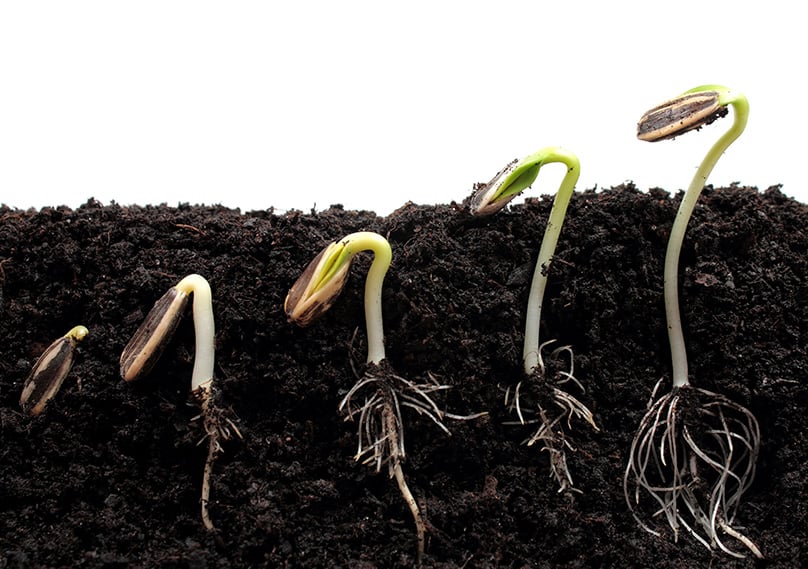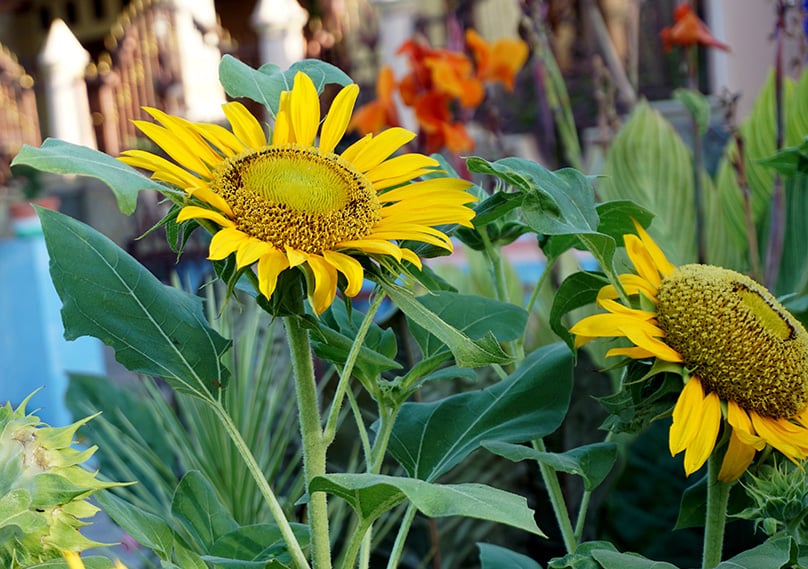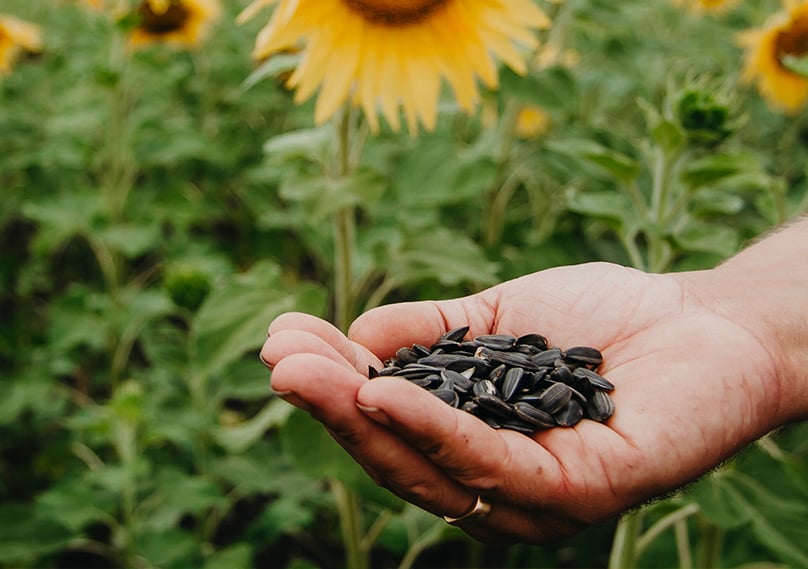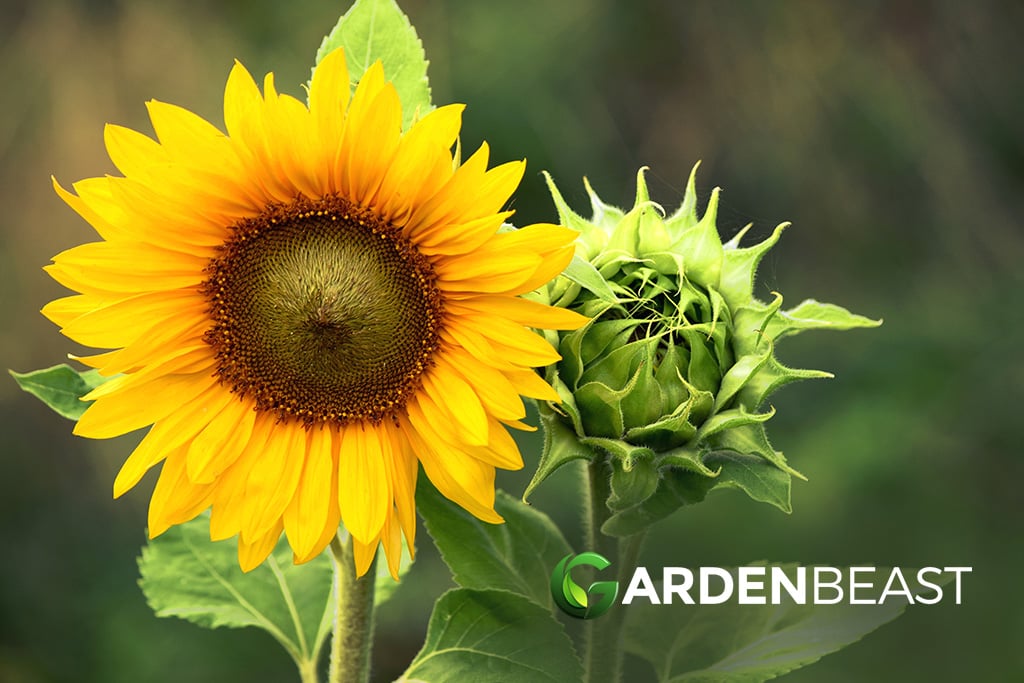Are you looking to add some cheer to your landscape? If so, plant some sunflowers!
They’re large blooms and bright yellow color that sit on top of tall, hardy stalks accented by large, vibrant green leaves look beautiful in a garden. They make wonderful cut flowers, too.
Sunflowers are pretty easy to grow, as they can easily adjust to pretty much any type of soil. However, like all plants, they do have certain requirements that must be met in order to ensure they’re success.
If you’re interested in growing sunflowers, you’re in the right place! In this guide, we provide all of the tips you need to grow some of the most cheerful flowers that Mother Nature ever created.
The History of Sunflowers
Before we jump in, we want to take a moment to share the history of sunflowers, as we feel that getting to know your plants helps you gain a better appreciation for them.
The history of modern sunflowers actually dates back to thousands of years ago. Historians have actually found evidence of the sunflowers that grow today at archeological sites that date back to 3,000 BC! That’s quite an impressive history.
Sunflowers naturally grew in abundance on America’s Great Plains. Evidence reveals that these bright, cheery flowers were first cultivated by Native American tribes in the Mississippi River Valley or the Southwest of the United States. They were grown for the fiber, oil, and seeds that they produced, as well as their medicinal properties.

When settlers from Europe arrived in the country, they instantly realize the value of the sunflowers, as they collected their seeds and sent them to Europe, where they were planted and grown, which is how they became a popular flower in the cottage gardens of England.
Sunflowers were so beloved in Europe that they became a popular subject of the paintings of one of the world’s most famous artists, Van Gogh.
Russians turned sunflowers into a significant crop, as the plants served as a source of oil that could be consumed without disobeying the dietary laws of their religion. In the early 1900s, Russian farmers led the proliferation and assortment of sunflowers that produced large amounts of oil and were resistant to diseases.
In the 1960s, sunflowers started to be grown commercially in the United States and used their seeds to create vegetable oil.
Despite their long history and natural growth in the United States, it wasn’t until pretty recently that gardeners started to realize the beauty of sunflowers.
Due to the increased interest as an ornamental plant, American, German, and Japanese growers started to develop sunflowers that were appropriate and would grow well in residential gardens.
How to Grow Sunflowers
There are dozens of varieties of sunflowers, including annual and perennials that return each year.
Home gardeners usually plant annual sunflowers, including dwarf and tall varieties that feature several branches and grow multiple blooms, which are ideal for cutting.
Sunflowers that are grown specifically for their seeds are annuals and there are a range of colors available, including light lemon yellow, bright yellow, pink, burgundy, and even bi-color and multi-color blooms.
Regardless of which type of sunflower you decide to grow, read on to learn some important tips so you can successfully grow sunflowers.
- 15 Packets of heirloom sunflowers seeds: 1000+ pcs, There are red, purple, pink, and yellow
- Packaging: 15 individual packets, Quality Sunflower seeds (Helianthus annuus) packaged; Intended for the current and the following growing season. grow a beautiful flower garden
- Planting method: Soaking seeds in cool water for 24 hours prior to planting will help speed up germination
- Easy To Grow: Sunflowers are some of the easiest to grow flowers. They don't need a lot of water but love the sunshine. Our variety pack is to give you sunflowers from 18" tall all the way up to 7 feet tall
- Annual: Grown as an annual flowering plant, Sunflowers will grow quickly, bloom profusely and later die with the first killing frost
- Sunflower Seeds for Planting – This planting packet includes 50 Mammoth Grey Stripe sunflower seeds (Helianthus annuus). Mammoth grey stripe sunflowers are some of the tallest sunflowers in the world. These flowers grow 9-12 feet tall with sun bursting yellow flower petals.
- Non-GMO Heirloom Sunflower Seeds – All of Axel’s Garden Seeds are Heirloom & Non-GMO and are intended for the current and following growing seasons. Fresh garden seeds are always provided.
- Planting Packets with Instructions – Our colorful planting packets include all the necessary information to grow these flowers successfully. Each packet is 3 x 4.5 with a beautiful full color illustration on the front with growing instructions on the back.
- Easy to Grow – Plant these seeds ½ inch deep in well-drained soil. Wait just 90-110 days for matured Mammoth Grey Stripe sunflowers. If any problems occur, Axel’s Garden Seeds will provide whatever is necessary for your gardening needs.
- Variety of Seeds for Home Garden – Axel’s Garden Seeds offers unique fruit, flower, herb, and vegetable seeds. Each packet is hand packed with high-quality garden seeds.
- Contains 5.25 oz. Bag with larger seeds that are perfect for snack time sharing
- All-natural ingredients and nutrients that will keep your energy up after snack time
- Roasted in the shell for a robust, satisfying crunch and lightly salted for taste
- Packed with nutritious unsaturated fats, fiber, and protein
- Keto friendly snack – 3g Net Carbs (5g total carbs minus 2g Dietary fiber), and 0g added sugar per serving
Last update on 2024-09-19 / Affiliate links / Images from Amazon Product Advertising API
When to Plant Sunflowers
- While you can plant sunflower seeds in doors in pots filled with peat, the easiest way to grow them from seeds is by sowing them right in the soil in the spring.
- It’s best to wait until the danger of frost has passed; however, in areas where that have a short growing season, sunflowers seeds can be planted two weeks before the last frost of the spring is expected, as the seeds are hardy and can usually withstand being exposed to cold temperatures for a short period of time.
- In regions where the growing season is long, the ideal time to plant sunflower seeds is when the ground temperature is between 55 and 60 degrees Fahrenheit.
Where Should Sunflowers be Planted?
- Sunflowers do best when they are grown in direct sunlight and well-drained, yet evenly moist soil.
- The amount of space that you’ll need to place between your flowers depends on the variety you’re growing.
- Sunflowers that branch and feature several blooms on single stems will require more horizontal space and large varieties that grow single flowers.
- When choosing a location, make sure that taller sunflowers are placed in a position where they won’t cast too much shade on shorter flowers, as all sunflowers love the sun.
- The north edge of a flower border would make the ideal location for these showy, cheerful flowers.
How to Prepare Soil for Sunflowers
Sunflowers will do their best when they are planted in soil that has been properly prepared. Mix about 3 inches of rich potting soil into your garden’s native soil.
Doing so will feed the seeds and ensure that the plants have strong roots so they can grow large, healthy blooms.
Watering Requirements
- After the seeds have been planted, make sure to water the soil thoroughly.
- While the seeds are sprouting, keep the soil damp, but not water-logged, as you don’t want to drown them.
- Most sunflower varieties are pretty drought-tolerant once they’ve established themselves; however, they will bloom better if they are watered on a regular basis.
- Water when the top two inches of the soil is dry.

Feeding Sunflowers
Though sunflowers don’t require much food, they’ll grow more and healthier blooms when they receive a steady amount of nutrition.
About a month after the seeds have been planted and are established in the soil, you can feed them with a all-purpose plant food.
Staking Sunflowers
Staking isn’t always necessary; however, if the stems aren’t very strong, the plant grows extremely tall, or there are several blooms, you may need to stake your sunflowers.
- If you’re growing a large amount of sunflowers to cut, create rows of staggered sakes with about 3 feet of space between each one.
- Wrap twine around the stakes to create a latticework. Alternatively, you can wait to stake the plants until they grow.
- Situate a sturdy stake about 3 inches from the stem of any sunflowers that are drooping and loosely tie them to the stake with twine.

Keeping Pests at Bay
Sunflowers are pretty carefree; however, certain pests can pose problems. Vermin, such as chipmunks and squirrels, can be problematic when sunflower seeds are first planted and before they are established, as these critters love to eat the seeds.
To keep them at bay, mix ground cayenne pepper into the ground around the seeds to deter them. If chipmunks and squirrels are a problem in your area, instead of sowing outdoors, you may want to start them indoors and then transfer them into the soil once they have sprouted.
Sunflower moths can also be problematic. They can lay their eggs on the growing blooms and the larvae feed on the flowers, destroy the seeds, and create webbing and leave debris on the plants.
If you notice this problem, remove the worms from the plants by hand and be sore to exterminate them.
If a lot of plants have become infested with sunflower moths, you can dust or spray the flowers with something that contains Bacillus thuringiensis as soon as the larvae appear. As they larvae eat the bacterium, they will die.
Disease Prevention
Again, disease usually isn’t a problem for sunflowers; however, they can be prone to certain types of fungal infections, such as rusts and mildews.
Downy mildew can mottle the plants and cause pale splotches on the upper surface of the leaves and mold on the underside. Eventually, the leaves will die. This problem is most likely to occur when the weather is warm and humid or when the evenings are cool and damp. Though Downy mold doesn’t kill sunflowers, it does impact their appearance.
Rusts can also grow on the surfaces of the leaves. First, it grows as yellow or white spots and become black or brown. Eventually, puffy-like blisters will develop on the undersides of the leaves. The disease can spread to the stems and flowers and impact the growth.
Keep an eye on your sunflowers. If you detect fungal disease, spray them with a standard fungicide. If plants are severally infected, remove them to prevent disease from spreading to healthy plants.
Keep the garden weeded, as fungal infections are usually spread by weeds, such as pigweed, wild mustard, and lamb’s quarters.
Harvesting Sunflower Seeds
In the fall, cut the flower heads when the back of the flowers have become black and the seed heads are dry. Leave the flower in a cool, dry location until it is completely dried out.
Using your thumbs, gently rub the flower head to loosen seeds. Collect the seeds and place them in a breathable paper or cloth bag. Store in a cool, dry location.

Conclusion
Sunflowers make a great addition to a garden. Their blooms add plenty of color and can be cut, and their seeds can be harvested and eaten as a healthy snack. If you’re considering planting sunflowers, make sure to follow the tips mentioned in this guide to ensure success.



